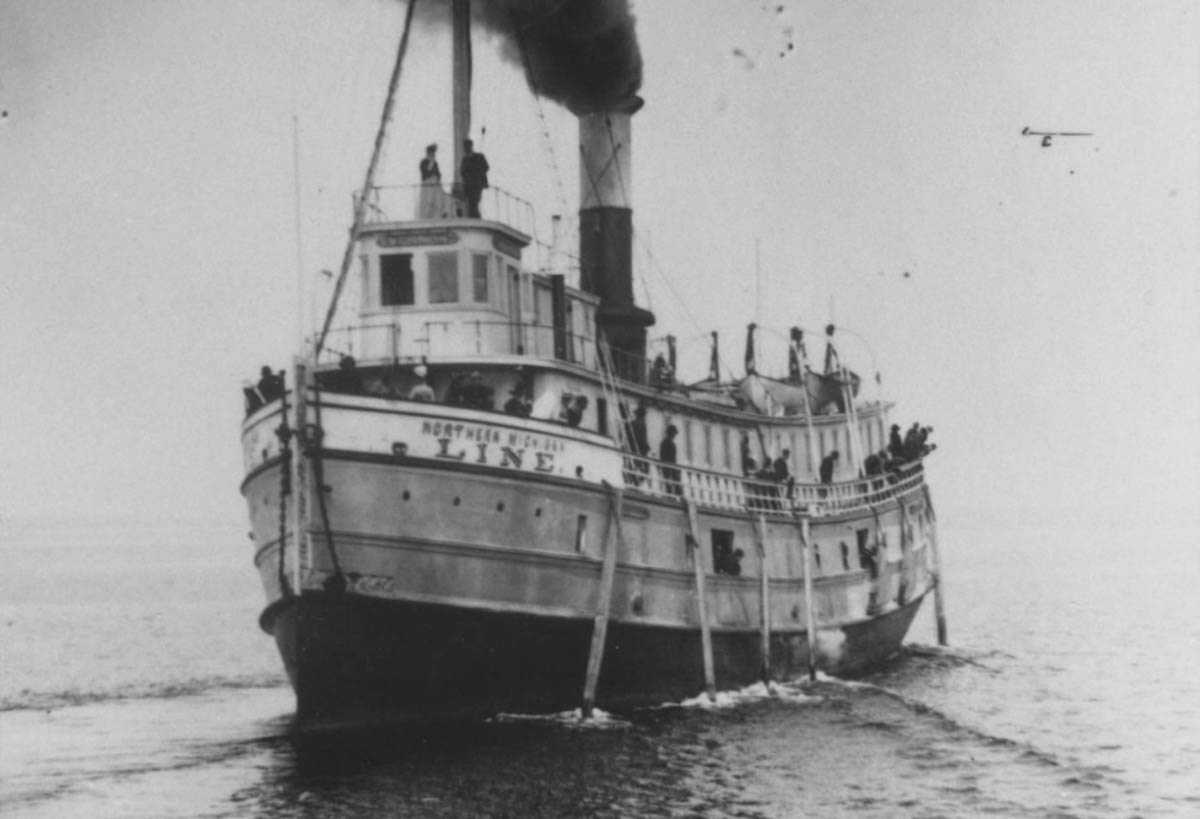In 1887 The Steamer Vernon sank near Two Rivers in a gale that swamped the ship taking the lives of almost 50 people with only a single survivor. It was a narrow vessel built in 1886 only a year before it’s sinking to carry passengers and freight. It could travel up to 15 mph which was fast for its time, but being so narrow and having a deep draft caused it to become unstable when carrying a full cargo at that speed.
The James P. Smith shipyard in Chicago, Illinois, constructed Vernon in 1886. She was constructed for Chicago native Alfred Booth. She took her position in the Duluth, Minnesota-Port Arthur, Ontario run on Lake Superior that same year, replacing the package freighter A. Booth, which went down on August 29, 1886, close to Duluth, Minnesota. Vernon was involved in the iron ore trade for a while in 1887, towing schooner barges between Cleveland, Ohio, and Lake Superior ports. Vernon briefly became the property of John Pridgeon of Detroit, Michigan, in July 1887. She was sold to him as payment for the harm Vernon had caused to his scow barges during their towing. That following August, Booth regained ownership of Vernon, which he ran as part of his Booth Packing Company. at order to replace their steamer Champlain, which had burned down at Charlevoix, Michigan, the Northern Michigan Line chartered her about the same time.
A two-cylinder compound engine with 565 horsepower (421 kW) fore and aft propelled Vernon; the engine’s cylinders had a stroke of 24 inches (61 cm) and bores of 22 inches (56 cm) and 40 inches (100 cm). Two 16-by-6.6-foot (4.9 m × 2.0 m) Scotch marine boilers operating at 125 psi (860 kPa) generated steam for the engine. The Marine Boiler Works in Chicago produced the boilers and engine.[5] A single fixed pitch propeller drove her to a maximum speed of 15 miles per hour (13 kn; 24 km/h).
Vernon was created to convey passengers and freight from Chicago to Manistique, Michigan/Northern Lake Michigan in as little time as feasible. She was considered one of the Great Lakes’ most graceful vessels. She was built for $78,000, or $2.34 million in 2023, and had 18 staterooms, a huge cabin salon, and numerous brass fittings.

Great Lakes shipping expert Steve Harold wrote that:
“From the start, the Vernon was known to have an unusual, perhaps defective, hull design. Even when empty, she had an extreme draft and sat very low in the water. Some people later declared it was even unsafe for her to carry significant amounts of cargo because she was then dangerously low in the water.”
Final Voyage
Under the command of Captain George Thorpe, Vernon sailed from Chicago, Illinois, to Cheboygan, Michigan, on October 20, 1887, with stops at Manitowoc, Wisconsin, Suttons Bay, Michigan, and St. Ignace, Michigan. Estimates of the number of crew members on board vary; most reports place it between 23 and 25. On her way back, Vernon was scheduled to stop at Mackinac Island and a number of other northern Lake Michigan ports on her way from Cheboygan to Chicago. Along with Joseph L. Hurd, a package freighter, she departed Cheboygan at approximately three in the morning. The two ships continued on to Beaver Island, where Joseph L. Hurd sailed to Chicago while Vernon loaded freight and passengers.
The next day, at 1:00 p.m., Vernon left Beaver Island and passed Leeland, Michigan. She stopped in Frankfort, Michigan, and then in Glen Haven, Michigan. Vernon departed Frankfort on the evening of October 28 and travelled to the Wisconsin shore of Lake Michigan. Vernon encountered a northeast breeze at about 10:00 p.m., which grew worse as she crossed the lake. Eventually, Vernon was flooded by the huge waves that made moving harder and harder, putting out her boilers. At some point between 3:00 and 4:00 a.m. on October 29, Vernon, now helpless, sank close to Two Rivers, Wisconsin. Four hundred boxes of fish, ninety tons of pig iron, apples, two thousand bushels of potatoes, ninety thousand barrel staves, and other general goods were on board when Vernon sank.
The schooner Joseph Page landed at Milwaukee, Wisconsin, late on the same day that Vernon sank; she reported seeing a “large, white propeller” with numerous people clinging to it and a lot of damage. Several life rafts and a yawl carrying survivors who were calling for help were spotted by the steamer Superior. Superior also came across life jacket-wearing individuals floating in the lake. Because of the gold scrollwork that was specific to Vernon, Captain Moran of Superior recognized the wreckage as belonging to him. While passing through a field of wreckage, the schooners Blazing Star, Horace A. Badger, William Home, and the tug Anderson came across multiple dead. No ship stopped to help the survivors as it went through the wreckage.
Only 19 bodies were eventually found and placed in the Two Rivers fire station, which was converted into a makeshift mortuary. At first, it was thought that fifty persons perished on the Vernon. Since several passengers boarded and disembarked at the ports where she stopped, this figure was eventually changed to 36–41 lives. Given the huge death toll, Vernon is among the deadliest shipwrecks to ever hit Wisconsin. Her estimated worth was $75,000, or $2.25 million in 2023.
At first, it was thought that Vernon’s crew had perished.On October 31, however, the schooner S.B. Pomeroy, sailing from Chicago, Illinois to Green Bay, Wisconsin, saw a life raft carrying two men. Axel Stone, a Swedish firefighter, age 23, had survived, while the other had perished from exposure. He was driven to Green Bay by S.B. Pomeroy, where he told the local press about the catastrophe. Vernon was so overloaded, according to Stone, that less than 6 inches (15 cm) of freeboard was left above the waterline. He stated that Vernon’s crew could not close the gangways because of the heavy load.
According to an inquest conducted on November 7, 1887:
Neither the lake nor the storm on October 29th were severe enough to make it impossible to retrieve these bodies. The five fishing tugs here, as well as other small boats, would have rushed to their aid if the life-saving crew had been aware of their dangerous situation.
The captains of Joseph Page and Superior were chastised during the inquest for not trying harder to save the survivors.
In 1908, two fisherman discovered a wreck, possibly the Vernon, 5 miles (8.0 km) offshore in 300 feet (91.4 m) of water, 8 miles (12.9 km) north of Two Rivers, Wisconsin. In 1969, Kent Bellrichard of Milwaukee, Wisconsin, discovered the wreck of Vernon. Northeast of Two Rivers, she lies undamaged in 210 feet (64 meters) of water. Her keel is shifted to the starboard side. West of her wreck, in 160 feet (48.8 meters) of water, are her pilot house and cabins that broke away when she sank. In her hold, her cargo remains intact.The fact that her gangways remain open supports Axel Stone’s assertion that her crew was unable to close them because of the heavy load.

A monument commemorating eight of the people who died onboard Vernon stands in the Pioneer Rest Calvary Cemetery in Two Rivers.





